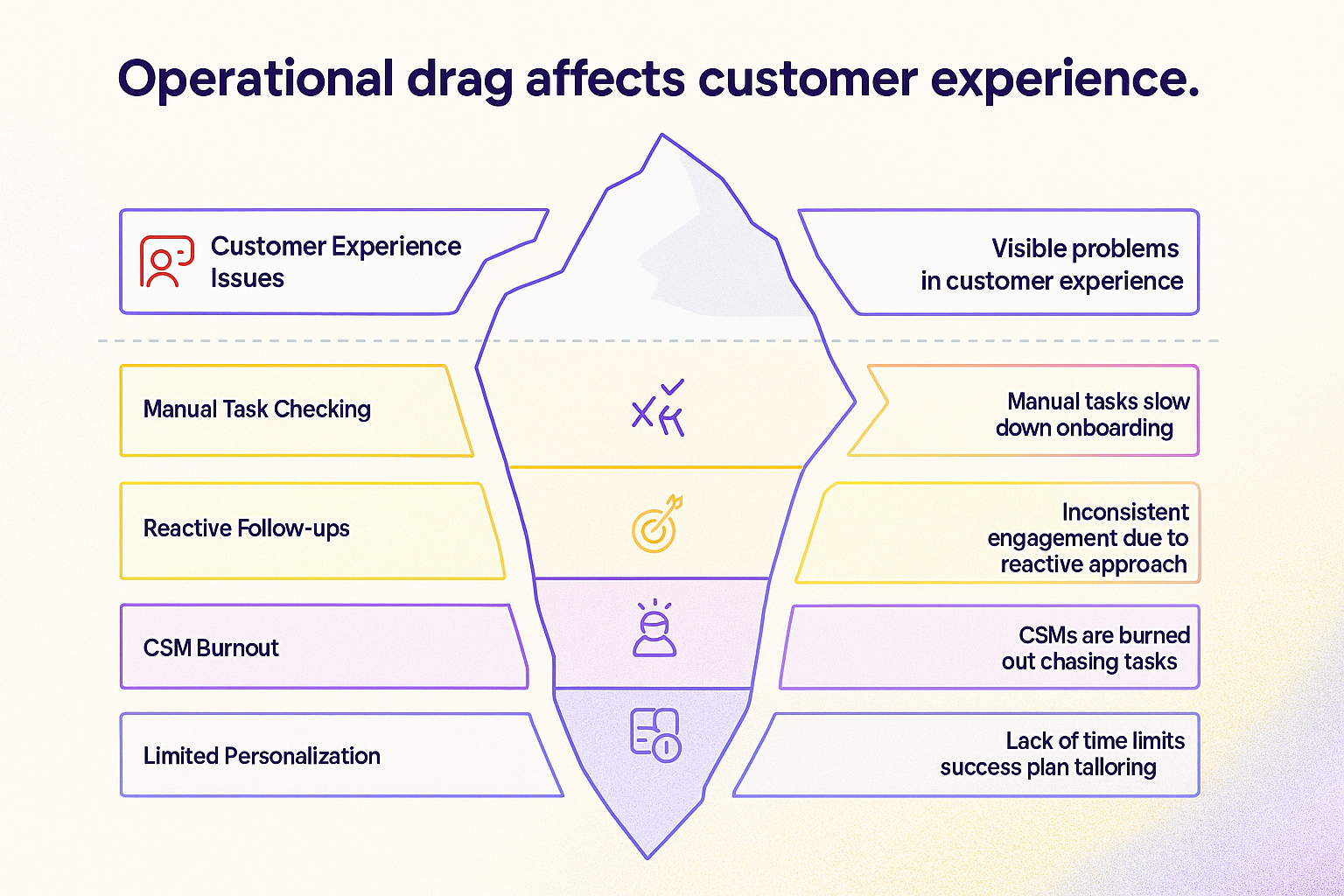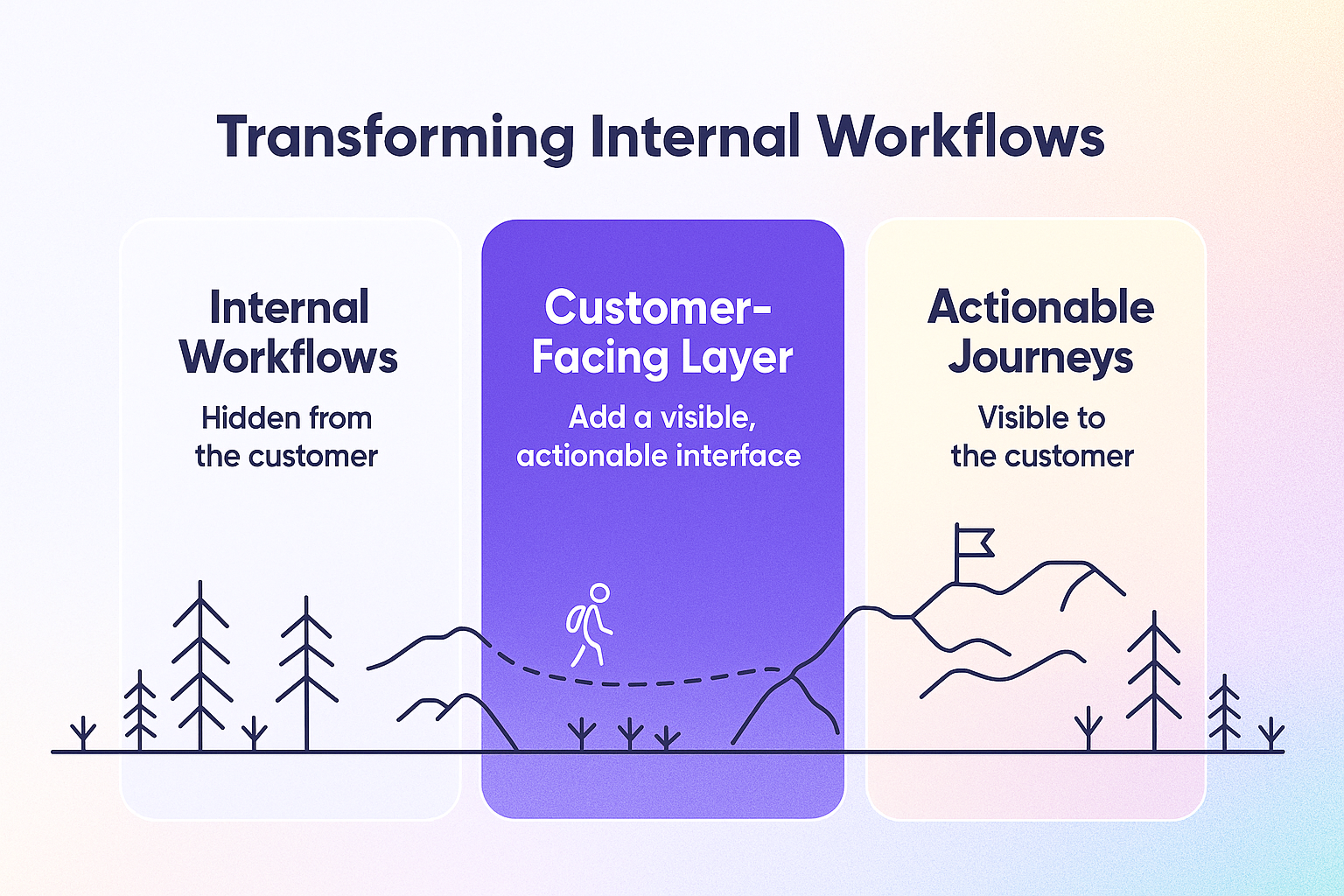TL;DR: CSM bandwidth is the #1 scaling barrier for 36% of CS teams—not AI, data, or budget. CSMs spend 70%+ of their week on routine tasks: onboarding check-ins (27%), follow-ups (24%), and progress reporting (21%). Mid-market teams feel this most acutely. The solution? Digital customer interfaces that automate routine touchpoints while preserving strategic relationships. Early adopters see 40% reduction in manual tasks within 3 months.
The #1 Barrier to Scaling CS Isn't AI. It's Your Calendar. This is the third blog in our 2025 CX Benchmark Series, where we explore the most urgent challenges (and opportunities) facing digital customer success teams today. Our first post unpacked the top trends from EverAfter's 2025 Customer Experience Benchmarks Report. The second dove into why AI personalization is still stuck in pilot mode. Now, we're tackling a quieter but more dangerous problem: the bandwidth crisis. If your CSMs feel like they're constantly running out of time, they're not alone. According to our benchmark data, 36% of CS leaders ranked "CSM time and capacity" as their number one blocker to scale. That beats out data silos (22%), tooling gaps (18%), and even budget (15%). The message is clear: The biggest barrier to scaled customer success isn't strategy, tech, or talent. It's hours in the day.
What the Data Says: Where the Time Goes
The bandwidth problem isn't abstract. It shows up in CSM calendars, overflowing inboxes, and endless progress check-ins. Our report reveals:
- 27% of team time goes to onboarding check-ins
- 24% to follow-up emails
- 21% to progress reporting
That's over 70% of a typical CSM's week spent on activities that, while important, pull them away from strategic work. As one respondent put it, "Behind every missed adoption target sits a calendar full of follow-ups." The impact is most severe in mid-market teams, who are juggling too many accounts for high-touch service but don't yet have the infrastructure to go fully digital. 38% of mid-market leaders say routine follow-ups are their single biggest time sink, nearly 2x the rate of their enterprise peers.
{{benchmarks-report}}
The Ripple Effect of Time Drain
This kind of operational drag doesn't just burn out your team—it affects every layer of customer experience:
- Slower onboarding: When every task is checked manually, time-to-value stretches.
- Inconsistent engagement: Reactive follow-ups mean customers get attention only after something slips.
- Burned-out CSMs: Instead of coaching customers, they're chasing tasks.
- Limited personalization: Without time, tailoring success plans for the long tail becomes impossible.
These aren't isolated symptoms, they're part of a systemic issue. If your delivery model relies on CSM heroics, it doesn't scale.

You Can't Automate What Customers Can't See
Here's the paradox: most CS teams have great playbooks, lifecycle stages, and onboarding flows. What they don't have is the bandwidth to deliver those experiences consistently. Why? Because most of those workflows are internal-facing. Even after years of investment, 68% of orgs still run outreach manually via spreadsheets, CRM lists, and one-off email templates. The tools exist. But without a way for customers to see and drive their own journey, automation has no place to live. It's like designing a highway with no on-ramps.
What the Leaders Are Doing Differently
Our benchmark data shows a clear pattern: high-performing teams aren't working harder—they're designing smarter systems.
- Scaling teams use 2x more automated workflows than foundational ones.
- Manual touches per CSM drop from 28 to 12 as automation takes hold.
- Workflow automation and self-serve engagement are now top investment priorities for CS orgs going into 2025.
As Zara Palevani, Director at Merkle, shared in the report:
If I could add one capability for 2025, I'd choose a unified personalization layer across all touchpoints. One that auto-adapts based on lifecycle stage, intent signals, and tech stack maturity.
Solving the Bandwidth Problem Starts with Visibility
One of the most striking stats in the report comes from mid-market firms: 53% say journey visibility is their #1 need going into 2025. These teams have playbooks, but no way to track customer progress outside of spreadsheets and status meetings. This is where the conversation shifts from tools to infrastructure. CSM bandwidth doesn't get solved by doing less, it gets solved by letting customers do more. Enter the Customer Interface: A New Front-End for Your Playbooks.
The benchmark trends point to a missing piece: a customer-facing layer that transforms internal workflows into visible, actionable journeys.
- Onboarding checklists update as customers complete steps
- Success plans reflect real-time data, not last quarter's slide deck
- Follow-ups become system-triggered nudges, not manual tasks
By giving customers a centralized space to engage, track goals, and collaborate, you create leverage. Suddenly, every touchpoint doesn't need to be human-led. With AI agents integrated into customer-facing interfaces, teams can automate routine interactions while maintaining personalized experiences.
{{benchmarks-report}}
As the report notes:
EverAfter customers report a 40% drop in manual follow-ups within three months.
The takeaway? A customer interface doesn't replace your CSMs. It amplifies them. When combined with intelligent AI agents that can handle routine tasks and provide predictive insights, CSMs can focus on high-value strategic work.

Real-World Example: Orca Security
Orca Security faced the same challenge that many high-growth companies do: how to deliver a consistent experience across a rapidly growing book of business. Their CS team needed a way to scale without sacrificing personalization. By launching a branded customer interface through EverAfter, Orca empowered customers to:
- Track onboarding progress
- Access key milestones and resources
- View their health scores and success plans in real time
The results? Faster onboarding, reduced email volume, and more time for strategic coaching. Modern AI agents can enhance this further by automatically identifying when customers need help and proactively suggesting resources or triggering appropriate interventions.
Closing Thought
You can't scale what your team has to manually deliver. And you shouldn't have to. The 2025 benchmark data is clear: the next leap in customer success isn't more people—it's better systems. Ones that protect your team's time, while giving customers more control. What would change if your CSMs spent 50% less time chasing updates—and 50% more time driving outcomes? For more insights, revisit The 2025 Digital Customer Success Benchmark.




.png)

.png)




%20(1).png)
















.png)
.png)
.png)



.avif)



.png)
.png)
.png)
.png)
.png)







